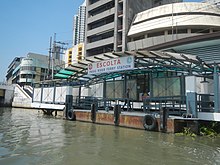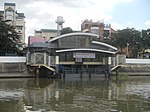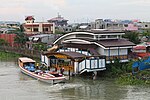
Transportation in the Philippines covers the transportation methods within this archipelagic nation of over 7,500 islands. From a previously underdeveloped state of transportation, the government of the Philippines has been improving transportation through various direct infrastructure projects, and these include an increase in air, sea, road, and rail transportation and transport hubs.

Metropolitan Manila, formally the National Capital Region and commonly referred to as Metro Manila, is the capital region and largest metropolitan area of the Philippines. Located on the eastern shore of Manila Bay, the region lies between the Central Luzon and Calabarzon regions. Encompassing an area of 619.57 km2 (239.22 sq mi) and with a population of 13,484,462 as of 2020, it is composed of sixteen highly urbanized cities: the capital city, Manila, Caloocan, Las Piñas, Makati, Malabon, Mandaluyong, Marikina, Muntinlupa, Navotas, Parañaque, Pasay, Pasig, Quezon City, San Juan, Taguig, and Valenzuela, along with one independent municipality, Pateros. As the second most populous and the most densely populated region in the Philippines, it ranks as the 9th most populous metropolitan area in Asia and the 6th most populous urban area in the world.

The Pasig River is a water body in the Philippines that connects Laguna de Bay to Manila Bay. Stretching for 25.2 kilometers (15.7 mi), it bisects the Philippine capital of Manila and its surrounding urban area into northern and southern halves. Its major tributaries are the Marikina River and San Juan River. The total drainage basin of the Pasig River, including the basin of Laguna de Bay, covers 4,678 square kilometers (1,806 sq mi).

Pasig, officially the City of Pasig, is a highly urbanized city in the National Capital Region of the Philippines. According to the 2020 census, it has a population of 803,159 people.
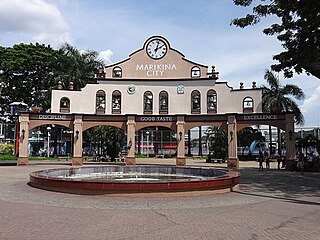
Marikina, officially the City of Marikina, is a 1st class highly urbanized city in the National Capital Region of the Philippines. According to the 2020 census, it has a population of 456,159 people.

Antipolo, officially the City of Antipolo, is a 1st class component city and capital of the province of Rizal, Philippines. According to the 2020 census, it has a population of 887,399 people. It is the most populous city in the Calabarzon region, and the seventh most-populous city in the Philippines. And also, it is the most populated city under the component city status.

Bayani Flores Fernando was a Filipino politician, businessman, and professional mechanical engineer who served as the representative for Marikina's 1st congressional district from 2016 to 2022. The son of a former Marikina mayor, Gil Fernando, he served as the ninth mayor of Marikina from 1992 to 2001, leaving the office having transformed the city from a former municipality to a model Philippine city. He was also a vice-presidential candidate for the 2010 election.
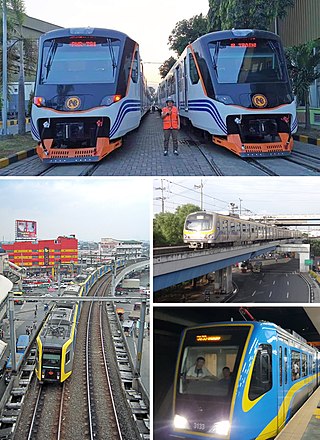
Rail transportation in the Philippines is currently used mostly to transport passengers within Metro Manila and provinces of Laguna and Quezon, as well as a commuter service in the Bicol Region. Freight transport services once operated in the country, but these services were halted. However, there are plans to restore old freight services and build new lines. From a peak of 1,100 kilometers (680 mi), the country currently has a railway footprint of 533.14 kilometers (331.28 mi), of which only 129.85 kilometers (80.69 mi) are operational as of 2024, including all the urban rail lines. World War II, natural calamities, underspending, and neglect have all contributed to the decline of the Philippine railway network. In the 2019 Global Competitiveness Report, the Philippines has the lowest efficiency score among other Asian countries in terms of efficiency of train services, receiving a score of 2.4, and ranking 86th out of 101 countries globally. The government is currently expanding the railway network up to 1,900 kilometers (1,200 mi) by 2022 through numerous projects.

The Metropolitan Manila Development Authority is a government agency of the Philippines responsible for constituting the regional government of Metro Manila, comprising the capital city of Manila, the cities of Quezon City, Caloocan, Pasay, Mandaluyong, Makati, Pasig, Marikina, Muntinlupa, Las Piñas, Parañaque, Valenzuela, Malabon, Taguig, Navotas and San Juan, and the municipality of Pateros.

Santolan station is an elevated Light Rail Transit (LRT) station located on the LRT Line 2 (LRT-2) system in Calumpang, Marikina. It is situated along the Marikina–Infanta Highway near its boundary with Pasig.
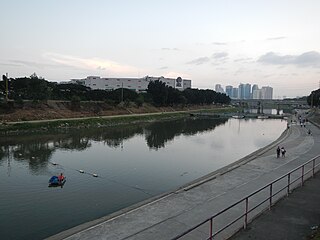
The Marikina River is a river in eastern Metro Manila, Philippines. It is the largest tributary of the Pasig River, with headwaters located in the Sierra Madre Mountains in Rodriguez, Rizal province.
DWAN is an upcoming radio station owned and operated by the Intercontinental Broadcasting Corporation. The station's studio is located at the IBC Compound, Lot 3-B, Capitol Hills Drive cor. Zuzuarregui Street, Brgy. Matandang Balara, Diliman, Quezon City and its transmitter is located in Valenzuela City.

The transportation system in Metro Manila covers the road network, rail network, ferries, ports and airports located with the metropolitan Manila area. Road transportation in Metro Manila is diverse, composed of many types of private and public transport vehicles. These include Taxis, buses, jeepneys, tricycles and pedicabs. In some areas, especially in Divisoria and large public markets, two-stroke motors are fitted in the pedicabs and are used for goods transport. Regardless of modernity, horse-drawn kalesas are still used in the streets of Binondo and Intramuros. Ridesharing services such as Grab also operate within in Metro Manila.

Francis Ng Tolentino is a Filipino politician and lawyer. He has served as a Senator since 2019.

Riverbanks Center is an integrated development complex for shopping, recreational, business and commercial along Andres Bonifacio Avenue adjacent to Marikina River in Barangka, Marikina, Metro Manila, Philippines. It is home of the Philippine's biggest outdoor amphitheater and outlet center, and the location of once the world's largest pair of shoes.

The Pasig River is a river in the Philippines running right through the heart of Manila. It flows from Laguna de Bay to Manila Bay through a length of 26 kilometers (16 mi) and an average of 50 meters (160 ft) in width. The average depth of the river in around 4–6 meters (13–20 ft). The river runs through some of the most populated areas in the Philippines.

The following outline is provided as an overview of and topical guide to Metro Manila:

The following is an alphabetical list of articles related to the Philippine capital region of Metro Manila.
The Makati Intra-city Subway or (MkTr) is an under-construction underground rapid transit line to be located in Makati, Metro Manila, that will link establishments across the city's business district. It will be built under a public-private partnership program between the Makati City Government and a private consortium, led by Philippine Infradev Holdings. Proponents of the subway are expected to begin construction by December 2018, and Makati Mayor Abigail Binay projects completion by 2025. The subway will cost $2.5 billion and is expected to accommodate 700,000 passengers daily. It will also have nine stations, with connections to the existing MRT Line 3, Pasig River Ferry Service, and the under-construction Metro Manila Subway.
The 2021 Metro Manila Film Festival (MMFF) is the 47th edition of the annual Metro Manila Film Festival. It is organized by the Metropolitan Manila Development Authority (MMDA). It was the second of the two editions to be held during the COVID-19 pandemic in the Philippines.







